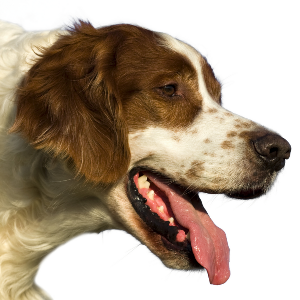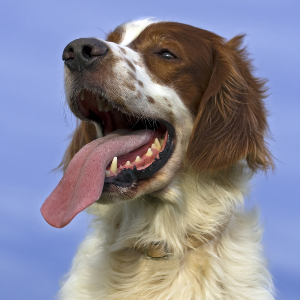
Irish Red and White Setter
The Irish Red and White Setter is a high-spirited, fun-loving breed. Field dogs through and through, Irish Red and White Setters are athletic and determined, with natural pointing abilities. It's no wonder hunters have considered the breed a valuable companion for centuries.
Interested in discovering if your dog is an Irish Red and White Setter?
Check out Wisdom Panel's DNA tests.

Irish Red and White Setter Traits
General Appearance
Bred for work in the field, the Irish Red and White Setter is strong, powerful, well-balanced, and athletic.
Coat and Colouring
The Irish Red and White Setter has long, silky feathering on the ears, back of legs, and tail. Likewise, the breed has feathering on the chest and throat that forms a fringe. On all other parts of the body, the hair is short and flat, with no curl.
As its name suggests, the Irish Red and White Setter's coat is white with solid red patches. The red color varies in shade from light honey to rich chestnut. It has flecking around the face, feet, and up the foreleg.
Distinctive Physical Traits
Irish Red and White Setters have broad heads and clean, square muzzles. Dark hazel or dark brown eyes offer a gentle, kind expression. The well-feathered tail is moderately long and tapers to a fine point.
Irish Red and White Setter Temperament
Intelligent and lively, Irish Red and White Setters thrive among families with active, outdoorsy lifestyles. These dogs are devoted and affectionate toward all members of their packs—including kids and other pets.
Irish Red and White Setters are fairly obedient and easy to housebreak. But they're also very independent. So, this breed can be a handful if not given plenty of exercise and consistent training.


Irish Red and White Setter History
The Irish Red and White Setter is a close relative of the Irish Setter. Though the latter is better known (and much more common), Irish Red and White Setters are actually the older of the two breeds, dating back to the 1600s.
Initially bred for their field talents rather than coat colors, Irish Red and White Setters proved to be natural pointers with the stamina and intensity to hunt all day long. As the breed evolved, increasing amounts of red appeared in their coats, with some dogs being entirely red.
In the 1800s, the red coloring grew more popular in the show ring. As a result, the all-red setters gradually became the most prominent variety. However, a public outcry to save the breed's traditional red and white color helped the Irish Red and White Setter survive.
The American Kennel Club accepted the breed in 1996 and awarded it full recognition in 2009. Today, only about 500 Irish Red and White Setters are in North America. And the breed still typically serves more as a field dog than a house dog. But when properly trained, the Irish Red and White Setter makes an obedient and loyal pet.
Irish Red and White Setter Care
Nutrition
Irish Red and White Setters require high-quality food that's appropriate for their life stage (e.g., puppy, adult, senior). A diet specifically formulated for the energy needs of active, medium-breed dogs is a great option to consider.
Irish Red and White Setters are at greater risk of bloat (also known as twisted stomach). To help prevent bloat, break their food up into several meals a day, and use a food bowl designed to slow their rate of eating. Avoid timing meals immediately after any kind of vigorous activity, and wait at least an hour before allowing your dog to run or exercise.
These are just a few ways you can help prevent this life-threatening condition. A veterinarian is the best resource for other recommendations—including surgical options—for preventing bloat.
To keep your Irish Red and White Setter at a healthy weight, monitor their food intake carefully. You can avoid overfeeding by measuring out their meals. And don't forget to count calories from treats in their daily totals. As a guideline, treats should make up no more than 10% of a dog's calories.
Grooming
Grooming an Irish Red and White Setter is a fairly low-maintenance job. Brush them once a week with a soft brush, and use a comb to work out any tangles.
Because Irish Red and White Setters have long ears, they may be more susceptible to ear infections. For this reason, check and clean their ears regularly to prevent infections from developing.
Maintaining good dental hygiene is essential for the overall long-term health of all dogs. In addition to professional dental cleanings, establish an at-home dental care routine that includes regular teeth brushing.
Exercise
Irish Red and White Setters need more exercise than most dogs. Daily long walks, runs, or hikes are all great activities to try. Alternatively, take advantage of the breed's intelligence, stamina, and instincts with competitive obedience and field trials.
Training
The Irish Red and White Setter's high-spirited temperament and stubborn streak can make it a challenging breed to train. Use short, upbeat training sessions to keep them engaged. Gentle persuasion and motivational tools such as treats and favorite toys may also be helpful.

Irish Red and White Setter Genetic Health Conditions
-
Rod-Cone Dysplasia 1
Rod-Cone Dysplasia 1 (rcd1) is an inherited eye disorder that results in blindness, and was identified in Irish Setters and Irish Red and White Setters.
-
von Willebrand's Disease, type 1
von Willebrand's Disease (vWD) Type 1 is a blood clotting disorder that typically causes mild bleeding tendencies although some affected dogs may have more severe signs. It is the result of low levels of von Willebrand's factor, a blood protein that helps stabilize blood clots.
Knowing if your Irish Red and White Setter is a carrier or at-risk for these conditions can help you and your veterinarian plan for your pup's lifelong care. With Wisdom Panel™ Premium, you can get results for over 200 genetic health tests.
Breed Group
Sporting
The sporting group breeds are incredibly diverse in personality and appearance, but can be characterized as very sturdy. They were developed to work closely with people and in general have a very responsive nature and high intelligence.
Resources
https://www.akc.org/expert-advice/lifestyle/5-reasons-irish-red-and-white-setter/
https://www.akc.org/dog-breeds/irish-red-and-white-setter/
https://www.irishredwhitesetterassociation.com/breed-history.htm
http://www.fci.be/Nomenclature/Standards/330g07-en.pdf
http://images.akc.org/pdf/breeds/standards/IrishRedWhiteSetter.pdf
Reviewed 26 July 2020 by Annette Louviere, DVM




































































